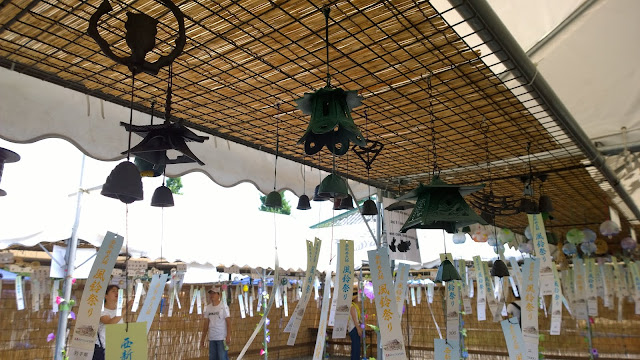Some people welcome the rains because raindrops on the roof make for a pleasant sound to fall asleep to.
I'm lucky that I need not wait for the rains to fall asleep to soothing, mellifluous tones --
I have a neem tree in the front yard laden with wind chimes that melodiously ring through the night.
All my wind chimes are made of metal -- they are souvenirs of my travels to Japan where wind chimes are much loved summertime symbols -- in the sweltering heat, their light tinkling heralds the
appearance of a much needed cooling breeze.
I can only surmise that it was a good wind that blew me, one sunny summer day in Tokyo, to the Sojiji Temple in Nishiarai. Unbeknownst to me, the temple was holding its annual furin or wind chime market. Someone at the temple told me that this furin market is one of the most popular in Japan. What a serendipitous moment for me to visit!
Japanese wind chimes are made of different materials -- from metal to ceramic to glass.
Sojiji's furin market had hundreds of all of these types on display, their different tones and tunes jangled merrily and somewhat chaotically each time a breeze blew by.
These chimes had come from all over Japan, from many different regions and prefectures.
I stood transfixed under the metal chimes -- these are the ones that I buy and collect.
There were so many new designs that I had never seen before. Metal chimes may not look as attractive or colourful as glass or ceramic chimes but I like their durability and the clear and round tones that they make.
As I stood there enjoying the music they made, I was in a near state of panic -- I couldn't quite choose from among the hundreds just which ones I wanted to buy.

The hand blown glass chimes gave off sweet, dulcet tones. They looked like colourful and fragile bubbles swaying in the wind. Glass chimes are usually called Edo chimes since they date back to
the Edo period when the Dutch brought advanced techniques of glassmaking to Nagasaki.
The Japanese quickly embraced the art of glassmaking and soon applied it to their wind chimes.

Ceramic wind chimes come from areas well known for their pottery traditions. This very
kawaii ceramic chime of Kumamon could only have come from Kumamoto where their pottery tradition goes all the way back to the 17th century.
Kumamon is my favorite Japanese mascot but sadly, I was afraid that this little ceramic bear would
not survive the trip back home.
All the chimes at the market were for sale. Each one on display is tagged with a number and a price. All I had to do was jot down the numbers of the chimes I had chosen and the ladies at the selling booth retrieved them from the available stocks, boxed, wrapped and ready to go.
If I had a bigger suitcase I would have bought more but I was more than happy with my small haul -- quite a heavy haul as all the wind chimes were made of metal.
Before I left, I breathed a silent thank you to the good wind that blew me here to Sojiji Temple to enjoy the symphony of sounds and colours at their once-a-year Furin Market.




No comments:
Post a Comment